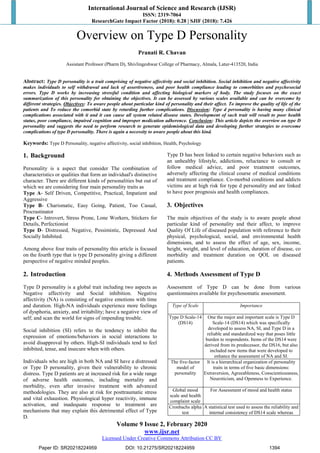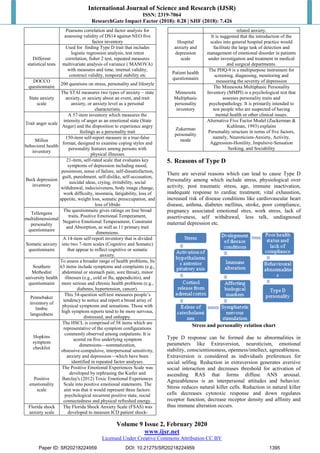This article provides an overview of Type D personality, characterized by negative affectivity and social inhibition, highlighting its correlation with poor health outcomes and increased risk for various comorbidities. It discusses the importance of awareness, assessment strategies, and potential interventions to improve the quality of life for affected individuals. The findings emphasize the need for further research on Type D personality and its implications on health and treatment compliance.



![International Journal of Science and Research (IJSR)
ISSN: 2319-7064
ResearchGate Impact Factor (2018): 0.28 | SJIF (2018): 7.426
Volume 9 Issue 2, February 2020
www.ijsr.net
Licensed Under Creative Commons Attribution CC BY
References
[1] Adan, A., Forero, D, A., & Navarro, J, F. (2017).
Personality Traits Related to Binge Drinking: A
Systematic Review. Frontiers in Psychiatry, 8, 134.
[2] Denollet, J. (1997). Personality, emotional distress and
coronary heart disease. European Journal of Personality,
11(5), 343-358.
[3] Denollet, J. (2005). DS14: Standard Assessment of
Negative Affectivity, Social Inhibition, and Type D
Personality. Psychosomatic Medicine, 67, 89–97.
[4] Denollet, J., & Brutsaert, L. (1998). Personality, Disease
Severity, and the Risk of Long-term Cardiac Events in
Patients With a Decreased Ejection Fraction After
Myocardial Infarction, American Heart Association, 97,
167-173.
[5] Denollet, J., & Kupper, N. (2007). Type-D personality,
depression, and cardiac prognosis: Cortisol dysregulation
as a mediating mechanism. Journal of Psychosomatic
Research, 62(6), 607-609.
[6] Harburg, E., Julius, M., Kaciroti, N., Gleiberman, L.,&
Schork, M, A. (2003). Expressive/Suppressive Anger-
Coping Responses, Gender, and Types of Mortality: a
17-Year Follow-Up (Tecumseh, Michigan,1971–1988).
Psychosomatic Medicine, 65, 588–597.
[7] Harvard medical school. (2014). Type "D" for distressed,
Harvard health publishing, Retrieved from
https://www.health.harvard.edu/newsletter_article/Type_
D_for_distressed.
[8] Kumar, P., & Singh, U. (2015). Zuckerman’s Alternative
Five Factor Model and Risk Taking Behavior, The
International Journal of Indian Psychology, 3(1), 123-
128.
[9] Li, X., Zhang, S., Xu, H., Tang, X., Zhou, H., & Yuan,
J., etal. (2016). Type D Personality Predicts Poor
Medication Adherence in Chinese Patients with Type 2
Diabetes Mellitus: A Six-Month Follow-Up Study.
PLoSONE, 11(2), 1-16.
[10]Martine E. H., Wolfgang, L., Andersona, J. C.,
&Weinberg, J. (2003). Type D personality is related to
cardiovascular and Neuroendocrine reactivity to acute
stress, Journal of Psychosomatic Research, 55, 235–245.
[11]Maschauer, E, L., Fairley D, M., & Riha, R, L. (2017).
Does personality play a role in continuous positive
airway pressure compliance? Breathe, 13, 32–43.
[12]Miller, G, E., Sheldon, C., Bruce, S, R., Skoner, D, P., &
Doyle, W, J. (1999). Personality and Tonic
Cardiovascular, Neuroendocrine, and Immune
Parameters, Brain, Behavior, and Immunity, 13,109–123.
[13]Moehler, E., Kagan, J., Parzer, P., Brunner, R., Reck, C.,
Wiebel, A., & etal. (2007). Childhood Behavioral
Inhibition and Maternal Symptoms of Depression,
Psychopathology, 40, 446–452.
[14]Mols, F., & Denollet, J. (2010). Type D personality in
the general population: a systematic review of health
status, mechanisms of disease, and work-related
problems, Health and Quality of Life Outcomes, 8, 9.
[15]Mols, F., & Denollet, J. (2010). Type D personality
among noncardiovascular patient populations: a
systematic review, General Hospital Psychiatry, 32, 66–
72.
[16]Mommersteeg, P., Kupper, N., & Denollet, J. (2010).
Type D personality is associated with increased
metabolic syndrome prevalence and an unhealthy
lifestyle in a cross-sectional Dutch community sample,
BMC Public Health, 10, 714.
[17]Perderson, S, S., Spek, V., Theuns, D., Alings, M.,
Voort, P, V., Jordeans, L., etal, (2009). Rational and
design of WEBCARE : A randomized, controlled, web-
based behavioral intervention trial in cardioverter-
defibrillator patients to reduce anxiety and device
concerns and enhance quality of life, BioMed Central,
10, 120.
[18]Watson, D., & Pennebaker, J, W. (1989). Health
Complaints, Stress, and Distress: Exploring the Central
Role of Negative Affectivity. American Psychological
Association, 96(2), 234-254.
Author Profile
Dr. Pranati R. Chavan with Pharm D as a
Qualification, completed Pharm D from Government
college of Pharmacy, Aurangabad and currently
working as a Assistant Professor in Shivlingeshwar
College of pharmacy, Almala, Latur.
Paper ID: SR20218224959 DOI: 10.21275/SR20218224959 1397](https://image.slidesharecdn.com/typedijsrpublication-200227145754/85/Type-d-ijsr-publication-4-320.jpg)